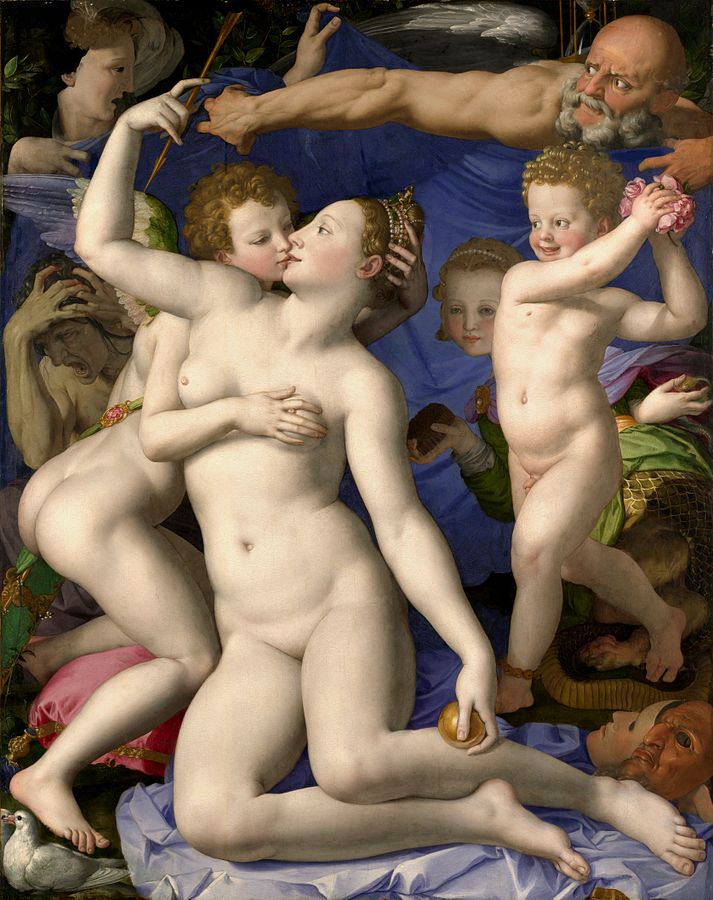Venus, Cupid, Folly & Time
This painting has got to be one of the weirdest in the whole of art history. I remember seeing it at the National Gallery many years ago. It is an image that is quintessentially Mannerist; it is artificial yet elegant, compositionally complex, intense in colour, and yet it is compelling, isn’t it? I love looking at this painting, it is eternally fascinating and compelling. It is his faces that attract me most, they are so stylised and are totally of their time and place. He also paints the most delicate fingers, like porcelain, very long and thin. His allegorical works all have a very angular and smooth look about them, like this one, probably his most famous. I just want to say that there is so much written about this painting, so I am only going to mention a couple of things. I am mostly deterred from writing an essay because even the most scholarly connoisseurs are confounded by much of its content. But I urge any one who feels so inclined to find out more about it.
The artist is Agnolo di Cosimo (1503-1572), more commonly known as Bronzino. The painting was probably commissioned by Cosimo I de’Medici, Grand Duke of Tuscany, Florentine prince, and a major patron of Bronzino’s. Cosimo wanted a gift for King Francis I of France, something elaborate and provoking, full of symbols that would be visually readable and appeal to the senses. It might be worth adding that the King was a scholarly, cultured and passionate man. Pagan subject matter was a popular choice for the learned nobility. The central woman is Venus the Roman goddess of love, accompanied as usual by Cupid, her son and the god of love. Nude, and kneels on the end of an ultramarine sheet which is being held up behind her, like a photographer’s backdrop. In her left hand she holds a golden apple, probably the one she won from Paris according to myth, in her right a sharp golden arrow which she poises gracefully in the air. Her bejewelled golden tiara marks her as a deity and adds to the opulent feeling of the painting. By her feet are very human looking masks. She turns to the right, showing us her beautiful profile, and her lips are met by those of her son. He is in the process of kneeling on a vivid pink cushion (a very Mannerist colour), showing his exotically winged back and the strap of his archers quiver as twists in an impossible contortion. By his feet are two white doves, a motif of love, peace, purity and of Venus’ Greek equivalent Aphrodite. The gaze Cupid holds with his mother is unnerving; his eyes are amorous and heavy-lidded, hers are serene and knowing. Not at all maternal. With a hand behind her head Cupid brings his mother’s face to his. Even more disturbing is what his other hand is doing. All this just in the foreground!
The rest of the scene is claustrophobic, there are four other characters squished into the remaining space. Folly, the chubby child on the right, is about to throw a handful of pink petals over Venus and Cupid. He too is naked, save for the bells on his left ankle. The other major subject is Time, the elderly fellow who is holding up the blue sheet aforementioned. I think he brings a fatherly figure to the image, marked out by the hourglass which sits on his shoulder between his wings. He seems to be moving, as Time does, and this gives the image energy. His attention has been grabbed by the strange creature at the other end of the picture, who helps him to hold the background up. Wikipedia says that this is usually called Oblivion, which would explain the black void behind his scary mask. A laurel wreath can be seen on the far left, usually symbolic of victory. Below Oblivion is Envy, tearing at their hair in a jealous rage. This figure has sometimes been referred to as Syphilis personified. On the left is Deceit, a sweet-faced girl with a dragonesque body, who crouches behind Folly. Under her green dress and pink cloak we can see her monstrously scaly middle and clawed feet. Her hands have been put on the wrong way, but her right one holds a lump of honeycomb while her left reaches out to the tasselled end of her long serpentine tail. If you look closely you will see that it is tipped by a stinger, an analogy to the weapon of the bees who make the delectable honey. The whole image warns of the dangers of love, the punishment of submitting to pleasure and sin. But as a viewer we do not share the same space as the characters. The mythological subject matter and lack of naturalism place his characters in a different realm to us, keeping them at a safe distance.
In his Lives of the Artists Giorgio Vasari wrote of Bronzino that he was a ‘painter truly most rare and worthy of all praise’, and this particular work to ‘be a picture of singular beauty’. However he also emphasised the influence of his tutor Pontormo, which although undeniable does take away from his own unique style. Bronzino’s works are instantly identifiable by their sophistication and exquisite detail, the other-worldliness of the marble-skinned figures. Many Mannerist works can be clumsy and jarring, especially in their colouring. His popularity and ducal patronage meant that Bronzino’s career spanned most of the 16th century. His inclusion of themes from Humanist writings such as Petrarch gave his art an intellectual edge, one that was exciting and engaging for viewers. His artistic genius and technical ability is evident in his fabulous aristocratic portraits and his symbol-loaded allegories, making Bronzino a true master.
p.s. In addition to this one the National Gallery has three other Bronzinos.

